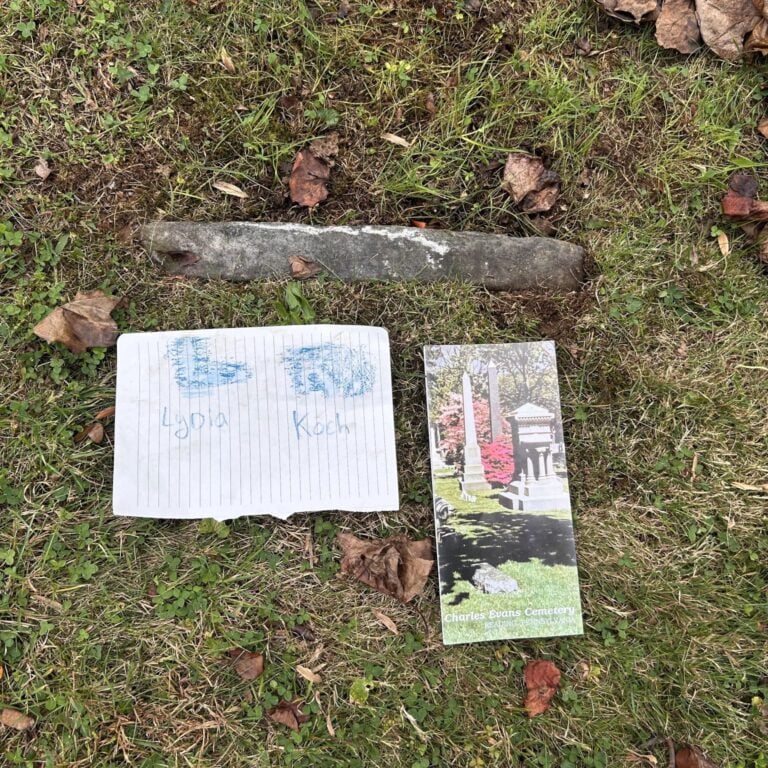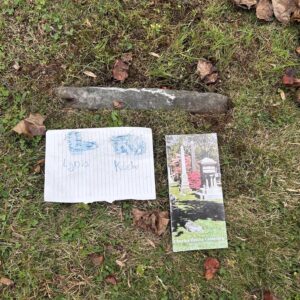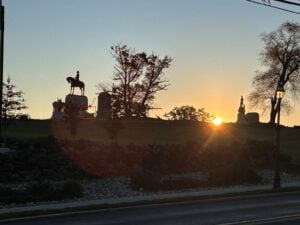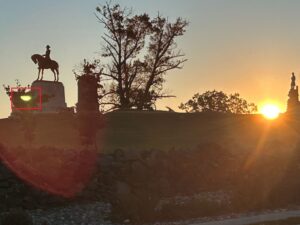I’ve been so busy with the Pickle Patch that I never got around to blogging about my upcoming family fall ancestry trip. You could say this trip took up a lot of my time to plan. I made sure we included some non-ancestry activities, which I labeled in my mind as “everyday living ancestry.” With most of the hotels booked, we set out— routes in GPS, research packed, and a little bit of a bumpy start.
Bumpy Start
The start of our trip was a little bumpy, as my 11-year-old grandson and husband were not exactly thrilled to go. My husband made it plain: this was my trip, and he was just coming along. Knowing this, I said, “Why don’t you both just stay home, and my daughter and I can take the trip?” Because of that—and not getting off as early as my itinerary had planned—we missed our first stop, which would have been really cool. Literally. The Lost River Cave.
All I can say is, it’s a good thing I didn’t book the tickets in advance. By the time we got near the cave location, all the tickets were sold out for the day.
So, we moved on to our next stop: Buc-ee’s. We wanted to experience it. It was impressive—and crowded—at the gas pumps and inside. Don’t get me wrong, the operation setup is well thought out. But I wanted fries with my brisket sandwich, and they had some kind of hot chips, which were not fries. The only way I could get fries was by buying the chicken tenders and fries combo. By the time I discovered this, I already had the brisket sandwich in my basket. So I got both—and shared the sandwich with my daughter, who picked up the salad.
We also bought two types of beef jerky. So: two chicken tender meals, two brisket sandwiches, a salad, one drink, and jerky—about $70 Buc-ee’s (or bucks). Honestly, we’re a little more particular than most—our degrees in food science tend to make us notice the details. On the whole, the brisket sandwiches had more fat and gristle than we’d prefer, and the jerky wasn’t quite up to our usual standard. When beef prices come down, I plan to make another batch of my own. It’s hard to beat homemade. I shared my jerky process in an earlier post titled Dried Okra— click here to see how I do it. Next day started with twisty curvy road to our next destination.
Twisty Curvy Road
This road was so twisty and curvy that we surely didn’t do the speed limit of 55 mph. Maybe if you’d lived there all your life, you could. Well, my grandson was in the backseat eating strawberries and blueberries and drinking milk for breakfast. I’m sure many of you already know where this is going. Let’s just say our rubber car mat took the brunt of it.
There was a silver lining, though. When we pulled off the road, a kind man who lived nearby came out to check on us. My husband asked if we could use his hose to rinse off the mat, and he graciously agreed. My grandson felt fine afterward—chatting with the man and happily petting his dog. The man even told us we weren’t far from the Bob Evans Festival, which just so happened to be our next stop.
Bob Evans Farm Festival
I’m not sure where I first learned that Bob Evans Farm was in Ohio, but while researching, I discovered it was pretty close to our route to Streetsboro, Ohio, for our ancestry trip. Our favorite breakfast restaurant in Memphis had closed, and since the farm also had a restaurant, we were excited to order the Homestead Farmer Breakfast, which included our favorite biscuits and sausage gravy. What luck—when planning our trip, I realized we’d be there during the 54th Bob Evans Farm Festival.
The festival is good ol’ family fun. There were plenty of food booths, and we considered buying a bucket of bean soup—cooked in large outdoor pots over open fire—but the wait was nearly two hours. Instead, we bought apple butter and sorghum syrup. We’ve been fond of apple butter ever since my husband worked at an apple processing plant early in our marriage. As for the sorghum syrup, we watched them grind the canes using a horse-powered grinder. The juice flowed into a holding tank, then into the cooker. We know it takes nearly 50 gallons of sap to make a gallon of maple syrup, but with sorghum, it takes about 12 gallons to make one gallon of syrup.
My daughter and grandson rode a few attractions—Swings, Tilt-A-Whirl, and maybe one or two others. It wasn’t anything like the big, expensive fair the family attended in September, but it had its own charm. One thing to note: to reach the fairgrounds, we had to walk through the “pig tunnel” to get to the other side. It was a safer option than crossing the busy road.
We didn’t eat at the Bob Evans Restaurant while at the festival, but we did stop at one in Streetsboro. Even though we love biscuits and sausage gravy, my husband was the only one who had breakfast—and he decided on pancakes and crispy bacon.
First Cemetery
Bob Evans Festival was the perfect stop before our three-hour drive to the final destination of the day: our first ancestry cemetery. It’s the resting place of my husband’s 5th great-grandfather, a Revolutionary War soldier. He and his wife migrated from Pennsylvania to Ohio in 1804 and are recognized among the First Families of Ohio. The cemetery is private and family-owned, with 36 graves.
For this trip, I made special Generations t-shirts. The front displayed my husband’s ancestral line, and the back featured mine. We wore them proudly for four days as we explored our family history. For photos taken at sites connected to my lineage, we simply turned our shirts around—so my ancestral line was front and center in the pictures.
I may not have mentioned this before, but our family is the keeper of my husband’s great-aunt’s genealogy book and all her files. While going through her materials, I found photos from her visit to the family cemetery from 1972—and also from my brother-in-law’s visit. Thanks to those, I knew exactly which graves to look for.
My main goal was to verify whether the headstone included the full date—years, months, and days—as listed in her genealogy book. That day, I corrected one error! I have to say, she did an excellent job with her research, especially considering it was all done before computers. Yes, it can be done—and I have the files and family group sheets to prove it.
One of her trademarks: when she needed to update anything, she couldn’t just click “reprint.” She typed a new page and pasted it over the old one. I have several copies in various stages of edits, each one a snapshot of her evolving research.
I was surprised when I compared the book she gave us—it didn’t include the updated information about the parents and grandparents of my husband’s 5th great-grandfather. That discovery was significant. It allowed us to add a meaningful stop before Gettysburg to honor my husband’s 6th great-grandfather, born in 1732 and died in 1823—making him 90 years old at the time of his death. Some strong genes in that German line!
Before our trip, I reached out to several historical societies, hoping to find other ways to help the family experience what life was like in the 1800s. At first, I was disappointed—many of the places we wanted to visit were only open a couple of weekends each month, and of course, not the weekend we were there. But I noticed a note saying they might open by request, so I sent an email—and to my delight, she opened the Singletary House Museum just for us.
This home was part of the Underground Railroad, but it also held mementoes of everyday life in Streetsboro and the surrounding area. Our family played a prominent role—one ancestor even wrote a book about his arrival and what life was like back then. It was a real eye-opener. The resilience and resourcefulness of that generation—especially leaving a 12-year-old out with just a loaf of bread, a few rounds of ammunition, and a rustic shelter for the summer until they brought the family—left us with a deeper appreciation for what they endured and overcame.
We had so much fun with Pearl, our guide or should I say friend, that we forgot to take any photos. I emailed Pearl to ask for a few pictures of her and the house, and I’ll create a memorable collage to send her—something special I’ll design in Canva.
After the tour, we hopped back into the car for a 5½-hour drive along the Ohio and Pennsylvania Turnpikes. At least for me as I was driving a leg of it, was a white-knuckle test in Pennsylvania, with sharp turns and three tunnels to navigate before reaching our next destination: Reading. That’s where I finally hoped to solve my Lydia mystery.
Reading, Pennsylvania
The day started out great. We found the Ringgold Artillery Monument in Reading’s city park—with a little help from one of the city park grounds crew. He was so nice he even took our photos for us. So that box was ticked.
Next, we tried to find Trinity Cemetery but ended up at Trinity Church instead. The GPS had clearly goofed—there should’ve been far more graves than the few tucked beside the church. We knew something was off. Luckily for us, there was an office right next to the little cemetery, and that’s where we learned the real Trinity Cemetery was closed due to issues with homeless encampments. I had hoped to find more of the Koch line there, but it wasn’t meant to be.
It was about time for me to do my “Big” research: confirming Lydia’s name—especially her maiden name. I was hoping the Berks County Genealogy Society would have church records or some document that confirmed her maiden name as Bennethorn, which appears on her son’s adult baptism record. That’s the only document listing it.
But there’s a complication. Her first name was recorded as Elisabeth on that baptism record, and again when her oldest son’s marriage was reported in the newspaper. So, uncertainty to say the least.
Over the years, I’ve kept searching, hoping new records would come to light. They haven’t. And that’s why I went to Reading—I’d been told there were more church books there that aren’t available online.
The Berks County Genealogy Society was only open from 12–4 p.m., and I used nearly all that time combing through their wall of church books, family files, and other resources. A big fat goose egg—and I was disheartened. This was the one thing I really needed to know. It’s hard going to an unfamiliar place trying to find something so specific. If it had been just me on this trip, I would’ve spent several days doing research. But we didn’t have that kind of time.
Before heading out the next day to visit my husband’s 6th great-grandfather’s grave in Arendtsville—just 8 miles from Gettysburg, our next destination—we stopped at the last thing I needed to do in Reading: a visit to Charles Evans Cemetery. Quite a few ancestors are buried there, including John D. and Lydia Koch. I knew John D. didn’t have a headstone, and I was really hoping the office might shed some light on Lydia’s maiden name in their records. But alas, it was not meant to be.
One thing I forgot to mention: John Daniel Koch’s death has always felt suspicious to me. Before the trip, I had hoped to obtain the coroner’s court file. They had to empanel a jury the day they found his body in the thicket. The newspaper article I found reports the jury ruled it suicide.
But here’s why I question it: he walked from his house at 954 Chestnut Street nearly two miles—almost to Alsace—through uphill terrain and brush. And the method? He slashed both his wrist and throat. How many suicides do you know that happen that way? Exactly. Very few.
It is sad he has no military headstone as he was in the Civil War twice, first as a private in the Ringgold Artillery where they were first to respond to defend Washington, D.C. and because they didn’t expect the war to last that long he had a 90 day term and then re-enlisted for another couple of years with the 6th PA Calvery Rush Lancers and earned the rank of first sergeant. but he didn’t fight at Gettysburg, but Antietam, which we visited over a year ago and drove past again to visit a friend because they said there were ghosts in her house. That will be at the end of my post.
To brighten my mood about Lydia, we did find her tiny headstone and if it wasn’t for my daughter paying close attention to the description of the location we would never have found it. Her stone is about 2 inches wide and maybe a foot long and is inset with the ground. The only way to confirm her headstone is that we did a crayon rubbing. L. K. showed up, and the others reference headstones matched. Here is what it looked like.
We visited several Koch-related family headstones that day, and even though I didn’t confirm Lydia’s name, I was able to confirm her resting place using some crayons and journal book paper. We hadn’t come prepared and just happened to acquire the crayons from a restaurant, where they were given with our kiddie menu.
Now, onto Arendtsville and then Gettysburg.
Arendtsville & Gettysburg
We met my husband’s brother at the Arendtsville cemetery, where not only was their sixth great-grandfather buried, but also the family of his youngest son. What made this visit special was that it wasn’t included in our edition of the book—just a speculative blurb suggesting it could be the start of the line. The grave was listed on Find a Grave, but GPS coordinates weren’t available. Before the trip, I contacted the person who had uploaded the photo to Find a Grave and asked if they had the coordinates to help us locate it more easily. He responded right away with the location, and we plugged it into our GPS and drove from Reading straight to the exact spot. How cool is that!
Of course, we took family photos, and they were instantly shared with our relatives on the West Coast, who couldn’t believe it! They also commented on our generation shirts.
When planning our return route, Gettysburg was the most logical stop—it was right in line with our trip home. It was actually a request from my daughter, who’s intrigued by the ghost aspect. We didn’t have time for the official ghost tours, but she and I did a little ghost hunting on our own. We visited a bridge known for paranormal sightings around 9 p.m. the first night and took lots of photos and videos—alas, no ghosts appeared in the images.
The next morning, while waiting for the family to wake up, I took a photo during my walk and showed it to my daughter. She said it could be something. So, to investigate, we retraced my steps. If you click the information icon on your image—at least with an iPhone—it shows the time and a map of your precise location. I was in the exact same spot when the sun was coming up. Well, let’s just say we debunked it: it was a glare on my lens.
My Ghost Photos
Instead of taking the typical park tour, we had our own private guide—our very knowledgeable brother-in-law. I wish I had prepared more for this part of the trip, as we had many ancestors who fought in the Civil War, and a few were at Gettysburg. But I had to confirm those details after the trip, since you really have to know when they mustered in and out.
John Daniel Koch, whom I mentioned earlier, mustered out on December 13, 1862—so he wasn’t at Gettysburg. But he was in and around the Maryland and Virginia areas and fought at the bloodiest one-day battle of the war: Antietam. I can now confirm that Willard Woods (my 3rd-g-grandfather paternal line)—who also served in the Mexican-American War and later re-enlisted for a three-year term—was at Gettysburg. He served in Company K of the 2nd Regiment of Vermont Infantry.
We also talked about a Confederate in the family who served with a Georgia regiment, as well as my husband’s third great-grandfather, who wasn’t at Gettysburg but fought at the Battle of Shiloh. He lost his pointer and index fingers after Shiloh, during the Battle of Stones River in Murfreesboro, Tennessee, and was mustered out after that.
We were in awe of our family—who can say that, through all these horrendous battles, their ancestors lived? Our family had some good luck during those times.
The last stop before heading out on our long drive home was a visit to a family friend in Shepherdstown—because my daughter had learned there were ghosts in her house.
Shepherdstown & Ghosts
When we arrived, we learned that our family friend’s house isn’t haunted after all—but it was used in some capacity during the filming of Ghosts of Shepherdstown. We plan to watch the paranormal reality series soon, when my daughter comes to visit.
Instead of taking house photos, we walked through the small town toward the restaurant. Along the way, she shared stories about Shepherdstown’s role in the Battle of Antietam. We strolled through a quiet cemetery where some of the town’s earliest families are buried. We took a few photos, but the ghosts weren’t being cooperative that day. My daughter is already making plans to visit Gettysburg and Antietam to explore both history and hauntings.
After lunch, we began our long drive home, talking about the trip and all the great finds we’d gathered along the way.
Long Drive Home
You’re probably wondering how far we traveled in just one week—it was a long loop, over 1,500 miles. No matter which state we passed through, road construction seemed to follow us, and eastern Tennessee was the worst. We waited nearly an hour just to go a few miles.
We didn’t start off smoothly—some in the group weren’t sure they wanted to go. But in the end, we all had such a good time. When planning the trip, I made sure every hotel had an indoor pool and a gym. The gym came in especially handy, since our grandson has been learning simple weightlifting and treadmill routines at home, and most hotel gyms had similar weights and machines.
I also brought a simple beach ball for the pool, and it turned into a nightly game: how long could we keep it going without missing? Our final record was 21. Our grandson said he loved the trip—and didn’t mind skipping the caves.
As for Lydia, if I ever need to go back, we can tie it to visiting family in Virginia. Reading is only about three hours from their house. I’m also thinking I might just pay the $60 and let the Berks County Genealogy Society find it for me.
This trip gave us a preview of what’s ahead—ancestry research and fun journeys across the pond. I realized that to make the most of our time, we’ll need to cluster our ancestry research—prioritizing what we want to uncover and which country (or countries) will give us the most research bang for our time. We covered a lot of miles and spent plenty of time in the car—but we had a wonderful time learning about our ancestry and enjoying a good ol’ family road trip.
Are we almost there??






Quite the trip report/ blogpost! The ghost-sighting was priceless 😉